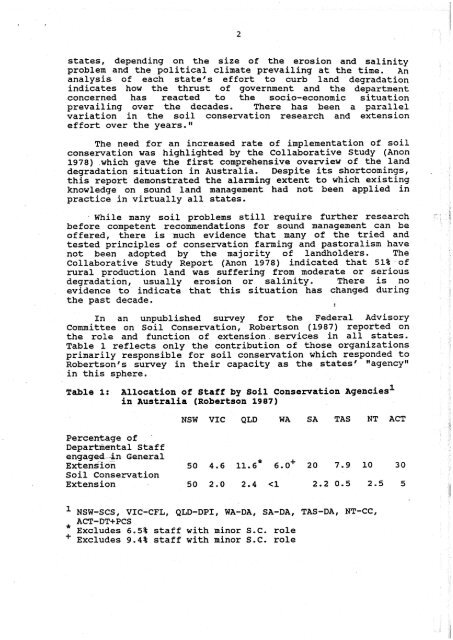soil-conservation-people-religion-and-land.pdf - South West NRM
soil-conservation-people-religion-and-land.pdf - South West NRM
soil-conservation-people-religion-and-land.pdf - South West NRM
You also want an ePaper? Increase the reach of your titles
YUMPU automatically turns print PDFs into web optimized ePapers that Google loves.
states, depending on the size of the erosion <strong>and</strong> salinity<br />
problem <strong>and</strong> the political climate prevailing at the time. An<br />
analysis of each state's effort to curb l<strong>and</strong> degradation<br />
indicates how the thrust of government <strong>and</strong> the department<br />
concerned has reacted to the socio-economic situation<br />
prevailing over the decades. There has been a parallel<br />
variation in the <strong>soil</strong> <strong>conservation</strong> research <strong>and</strong> extension<br />
effort over the years. l1<br />
The need for an increased rate of implementation of <strong>soil</strong><br />
<strong>conservation</strong> was highlighted by the Collaborative Study (Anon<br />
1978) which gave the first comprehensive overview of the l<strong>and</strong><br />
degradation situation in Australia. Despite its shortcomings,<br />
this report demonstrated the alarming extent to which existing<br />
knowledge on sound l<strong>and</strong> management had not been applied in<br />
practice in virtually all states.<br />
While many <strong>soil</strong> problems still require further research<br />
before competent recommendations for sound management can be<br />
offered, there is much evidence that many of the tried <strong>and</strong><br />
tested principles of <strong>conservation</strong> farming <strong>and</strong> pastoralism have<br />
not been adopted by the majority of l<strong>and</strong>holders. The<br />
Collaborative Study Report (Anon 1978) indicated that 51% of<br />
rural production l<strong>and</strong> was suffering from moderate or serious<br />
degradation, usually erosion or salinity. There is no<br />
evidence to indicate that this situation has changed during<br />
the past decade. 1<br />
In an unpublished survey for the Federal ~dvisory<br />
Committee on Soil Conservation, Robertson (1987) reported on<br />
the role <strong>and</strong> function of extension.services in all states.<br />
Table 1 reflects only the contribution of those organizations<br />
primarily responsible for <strong>soil</strong> <strong>conservation</strong> which responded to<br />
Robertson's survey in their capacity as the states* "agencyvg<br />
in this sphere.<br />
Table 1:<br />
Allocation of Staff by Soil <strong>conservation</strong> Agencies1<br />
in Australia (Robertson 1987)<br />
NSW VIC QLD WA SA TAS NT ACT<br />
Percentage of<br />
Departmental Staff<br />
engaged-in General<br />
~xtensi-an 50 4.6 11.6* 6.0' 20 7.9 10 30<br />
Soil Conservation<br />
Extension 50 2.0 2.4
















